Spotlight
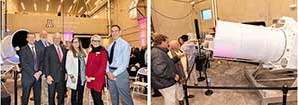
Grand opening of new Mission Integration Lab for balloon-borne astronomy
The University of Arizona on Monday celebrated the opening of the Mission Integration Lab, a new research building in the UA Tech Park at The Bridges that will accommodate testing and preparation for balloon-borne astronomy missions.
Balloon-borne astronomy fills an important niche between ground-based observatories and space telescopes, allowing for the deployment of telescopes and other instruments to altitudes where they experience less interference from Earth's atmosphere. Modern balloon-borne observatories offer space-like views of the universe at a fraction of the time and cost of a full space mission.
The Mission Integration Lab provides a tall, hangar-like space, known as a "high bay," which allows researchers to prepare and test balloon payloads and other space payloads before their flights.
The Monday event featured remarks from University of Arizona President Robert C. Robbins; Elizabeth "Betsy" Cantwell, UArizona senior vice president for research and innovation; and Carol Stewart, vice president for Tech Parks Arizona.
Equipment was on display from two balloon-borne missions:
- The Terahertz Intensity Mapper, a NASA-funded balloon mission designed to create a giant map of galaxies from over 5 billion years of cosmic history. The mission relies on an imaging spectrometer capable of detecting extremely faint galaxies in the "cosmic afternoon," the time when star formation in the universe was slowing down from its peak 10 billion years ago.
- GUSTO, short for Galactic/Extragalactic ULDB Spectroscopic Terahertz Observatory, a NASA-funded mission to carry an infrared telescope to study the lifecycle of stars in the interstellar medium.

The Dr. Elizabeth Roemer Endowed Chair in Steward Observatory
Author: Buell T. Jannuzi
Through the generosity of Richard F. Caris, the Heising-Simons Foundation, Larry and Susan Allen, & Trip and Ann Wolbach, we have been able to establish the first endowed chair in the history of Steward Observatory and the Department of Astronomy at the University of Arizona.
The endowed chair is named in honor of Dr. Elizabeth “Pat” Roemer (1929-2016), a highly valued member of the Department of Astronomy, LPL, and Steward Observatory during the 1960s through 1990s. We honor Dr. Roemer because of her notable contributions, not only to the University of Arizona, but to the fields of Astronomy and Planetary Sciences. By identifying her as an exemplar of excellence and a role model for all of us, we also want to encourage greater diversity and equity in science, so necessary to making progress on the grand scientific challenges we will address in the decades to come.
The inaugural holder of the chair is Regents’ Professor of Astronomy Marcia Rieke, a member of the National Academy of Sciences with a distinguished record of scientific and scholarly achievements in astrophysics, instrumentation, education, outreach, and service.
Marcia Rieke, like the distinguished professor in whose honor the chair is named, has a record of fostering and sustaining the inclusive and welcoming environment required to enable everyone to succeed in our field, independent of their race, gender, or background.
Our selection of Marcia Rieke as the first holder of the chair, coupled with the legacy of Elizabeth Roemer, establishes the high standards expected of future holders of the Dr. Elizabeth Roemer Endowed Chair in Steward Observatory.
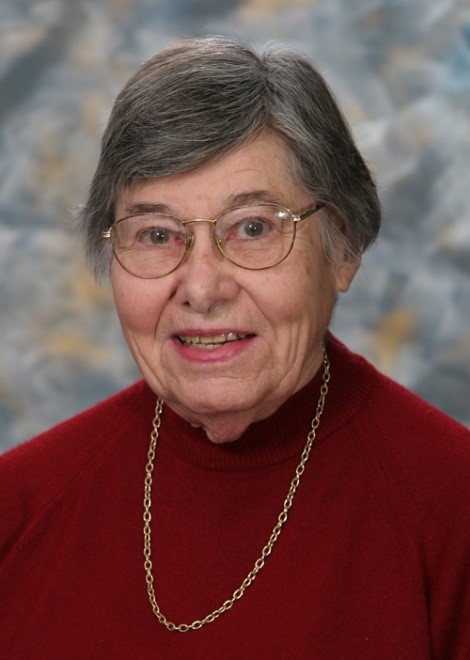
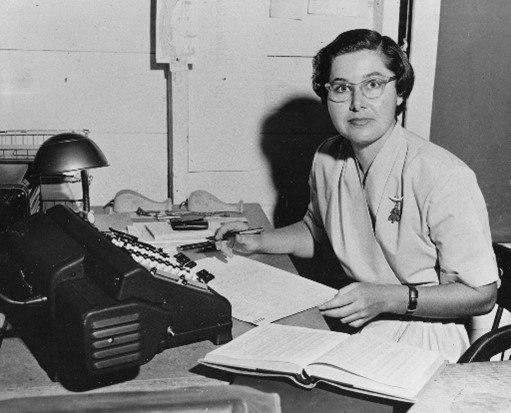
Additional Information about Dr. Elizabeth “Pat” Roemer
Professor Roemer was an expert in astrometry and her research focused on the study of comets and asteroids. She recovered, through her calculations and observations, 79 periodic comets. She specialized in astrometry, making precise measurements of the positions, motions, and magnitudes of celestial bodies. She discovered the asteroids “1930 Lucifer” (1964) and “1983 Bok” (1975), and was a co-discoverer of Thermisto, one of Jupiter’s moons.
Pat was born in Oakland, California on September 4, 1929. She was valedictorian of her 1946 high school class and a winner of that year’s national Westinghouse Science Talent Search. She received a B.A. in Astronomy as a Bertha Dolbeer Scholar in 1950 from the University of California, Berkeley, where she also earned a Ph.D. in 1955. She began to develop her love for teaching while supporting herself through graduate school by teaching classes at local public schools. After completing her degree, she worked as an assistant astronomer at the University of California while also conducting research at the University of Chicago’s Yerkes Observatory, moving to the U.S. Naval Observatory in Flagstaff, AZ in 1957. In 1966, she joined the UArizona as an associate professor in the Department of Astronomy and a researcher in the Lunar and Planetary Laboratory (LPL). She was promoted to full professor in 1969. In 1972 she lead the committee that recommended the establishment of the Department of Planetary Sciences. After retiring, Professor Emerita, in 1997, she continued to be an active member of the astronomy community.
As a female professor in a male-dominated community, Pat Roemer was an early pioneer for women scientists in astronomy. She held leadership roles in many astronomical commissions and organizations and earned numerous awards for her groundbreaking work. She served as president of the International Astronomical Union Commission 6 (Astronomical Telegrams) and vice president of Commission 20 (Positions and Motions of Minor Planets, Comets, and Satellites). She served as chair of the American Astronomical Society Division on Dynamical Astronomy. Among her many awards were the B. A. Gould Prize of the National Academy of Sciences, the NASA Special Award, and the Donohoe Lectureship of the Astronomical Society of the Pacific. In 1961, Asteroid “1657 Roemera” was named in her honor.
Additional Information about Dr. Marcia Rieke, First Holder of the Dr. Elizabeth Roemer Endowed Chair in Steward Observatory:
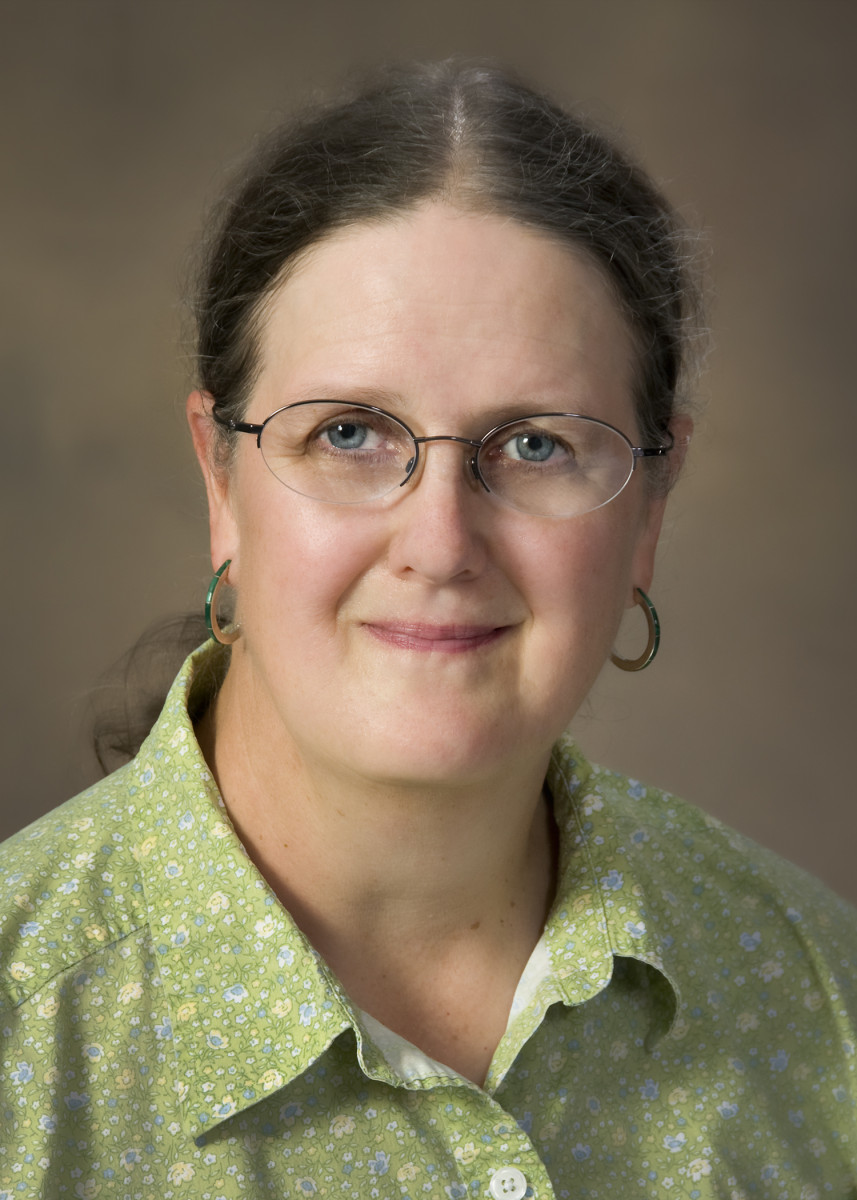 Marcia Rieke’s research interests include infrared observations of the center of the Milky Way and of other galactic nuclei and observation of the infrared sky at as faint a level as possible to study distant galaxies. These research interests have driven her to characterize and develop large-format, low-noise infrared detector arrays. She received her undergraduate and graduate degrees in physics from the Massachusetts Institute of Technology. She came to the UA in 1976 as a postdoctoral fellow and joined the faculty as an Assistant Astronomer in Steward Observatory. She has served as the Deputy Principal Investigator on NICMOS, (the Near Infrared Camera and Multi-Object Spectrometer for the Hubble Space Telescope), the Outreach Coordinator for the Spitzer Space Telescope, and now is the Principal Investigator for the near-infrared camera (NIRCam) for the James Webb Space Telescope. She also has been active in using Arizona’s ground-based telescopes. She served as the Vice Chair for Program Prioritization for Astro2010 and was the Chair of the Astro2020 Panel that reviewed planned OIR space facilities and missions. She is a member of the American Academy of Arts and Sciences and of the National Academy of Sciences. She has been a positive force for the creation of a strong Department/Observatory with a welcoming and safe environment for all, through her recent tenure as the Associate Head of the Department and as past chair of the Department’s Diversity and Inclusiveness Committee.
Marcia Rieke’s research interests include infrared observations of the center of the Milky Way and of other galactic nuclei and observation of the infrared sky at as faint a level as possible to study distant galaxies. These research interests have driven her to characterize and develop large-format, low-noise infrared detector arrays. She received her undergraduate and graduate degrees in physics from the Massachusetts Institute of Technology. She came to the UA in 1976 as a postdoctoral fellow and joined the faculty as an Assistant Astronomer in Steward Observatory. She has served as the Deputy Principal Investigator on NICMOS, (the Near Infrared Camera and Multi-Object Spectrometer for the Hubble Space Telescope), the Outreach Coordinator for the Spitzer Space Telescope, and now is the Principal Investigator for the near-infrared camera (NIRCam) for the James Webb Space Telescope. She also has been active in using Arizona’s ground-based telescopes. She served as the Vice Chair for Program Prioritization for Astro2010 and was the Chair of the Astro2020 Panel that reviewed planned OIR space facilities and missions. She is a member of the American Academy of Arts and Sciences and of the National Academy of Sciences. She has been a positive force for the creation of a strong Department/Observatory with a welcoming and safe environment for all, through her recent tenure as the Associate Head of the Department and as past chair of the Department’s Diversity and Inclusiveness Committee.Make a donation today to support the endowment!
Information in this web page article was contributed by various members of our faculty who knew Elizabeth Roemer and by articles or obituaries, including one by Antoinette Beiser in the Lowell Observer, the Quarterly Newsletter of the Lowell Observatory:
https://lowell.edu/wp-content/uploads/2016/10/Lowell-Observer-Issue-

Remembering William “John” Cocke 1937 - 2022
On July 4, 2022, at the age of 84, Professor Emeritus William Johnston Cocke III, aka John, “passed on to his next great adventure,” as his family communicated in his obituary. John is survived by Claire, two children Caitlyn and Nathaniel, his brother Stanley H. Cocke, and beloved grandchildren Patrick, Anika, Phobe, and Iris.
John was graduated from NC State (1959) and earned his Ph.D. in astrophysics from Cornell University in 1964, working under the supervision of Phillip Morrison. He then assisted with the invention of the GPS with the Navy as a civilian contractor in 1966. In August 1968, he accepted a position at Steward Observatory. He retired 32 years later, beloved by students and notably remembered for leading the team that discovered the optical pulsar in the Crab Nebula in 1968. John was also a self-taught master calligrapher.
To make a donation in John’s honor, his family would like you to support the next generation of Steward Observatory astronomers by donating to our fund which supports undergraduate, graduate, and post-doctoral fellows.
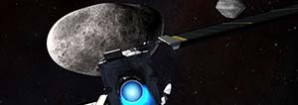
UArizona Spacewatch discovered the larger of the twin asteroids targeted in NASA's upcoming DART mission
On a spring night in 1996, a camera on the University of Arizona Steward Observatory's 36-inch telescope atop Kitt Peak captured three important images of a bright object sweeping across a backdrop of seemingly static stars.
The object turned out to be a half-mile-wide, potentially hazardous near-Earth asteroid, caught on camera by Joseph Montani, a member of the university's Spacewatch group in the Lunar and Planetary Laboratory. Originally dubbed 1996 GT, the asteroid would later be renamed Didymos – which is Greek for "twin" – at Montani's suggestion. The name was inspired by the discovery in 2003 that the asteroid has a small companion, only 525 feet across.
That companion – named Dimorphos, meaning having two forms – is the target of an upcoming NASA mission designed to test technology that could redirect asteroids that potentially threaten life on Earth.
Dimorphos and Didymos both orbit the sun, and the smaller of the pair orbits the larger one about once every 12 hours. Though Didymos and Dimorphos pose no threat to Earth, NASA identified Dimorphos as an ideal target to test asteroid redirection technology that could help protect Earth from future asteroid threats.
On Sept. 26, 2022, NASA's Double Asteroid Redirection Test, or DART, mission spacecraft will slam into Dimorphos, and scientists will closely study how the impact alters the smaller asteroid's orbit around Didymos. DART launched on Nov. 24, 2021.
Spacewatch is led by principal investigator Melissa Brucker. She is also on the science investigation team for DART. Spacewatch and other research groups plan to collect data on the light reflected from the two asteroids after impact.
"We'll take a long series of images to measure the brightness of the system over time. Didymos and Dimorphos will look brighter when they're next to each other than when one is in front. In a series of images, we will be able to determine how long it takes Dimorphos to orbit Didymos," Brucker said. "Working on this mission is very exciting. I've been working on near-Earth asteroid tracking for eight years, so being able to participate in the first planetary defense demonstration is a really great opportunity."
Spacewatch has long history of asteroid discovery
Spacewatch was founded by UArizona planetary scientists Tom Gehrels and Robert S. McMillan in 1980.
The original goal of Spacewatch was to survey and discover small objects orbiting the sun, such as asteroids and comets, to better understand the evolution of the solar system. Spacewatch started shifting focus in 1998 and now follows up on discoveries made by astronomical surveys, such as UArizona's Catalina Sky Survey, by monitoring the positions and movement of newly discovered potentially hazardous objects so that they do not become lost.
Spacewatch continues to use the Steward Observatory 0.9-meter (36-inch) telescope atop Kitt Peak, as well as the Lunar and Planetary Laboratory's 1.8-meter (72-inch) telescope, which has been operational on Kitt Peak since 2002.
New asteroids and comets are discovered by groups around the globe constantly, with astronomers slicing the sky into regions that telescopes survey multiple times a night, snapping images at each pass. Surveys capture each region three to four times a night.
Astronomers then compare the positions of moving objects to background stars in an image. They send the resulting measurements to the International Astronomical Union's Minor Planet Center, which takes the observations and determines orbits for the objects.
As one of the longest running asteroid tracking groups, Spacewatch can claim many firsts.
It was the first group to use a charge-coupled device, or CCD, camera to routinely survey the sky for comets and asteroids. It also claims the first CCD-discovered near-Earth asteroid, 1989 UP (now called 496816), and comet, dubbed 125P/1991 R2 Spacewatch. Spacewatch was also the first astronomical group to develop automated, real-time software for moving-object detection and the first to discover a near-Earth asteroid by software – 1990 SS (now called 11885 Summanus).
Between May 1984 and June 2022, using UArizona telescopes on Kitt Peak, Spacewatch submitted 15,777,248 astrometric records of asteroids and comets to the Minor Planet Center. Of those 151,805 were of 15,072 unique near-Earth objects, including 1,883 potentially hazardous objects.
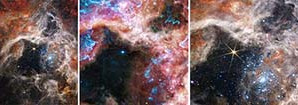
NASA’s James Webb Space Telescope presents a new perspective on the Tarantula Nebula
NASA’s James Webb Space Telescope presents a new perspective on 30 Doradus, or the Tarantula Nebula, a region well-know to astronomers studying star formation. Its nickname once came from its resemblance to the spider itself, but in Webb’s view the overall region takes on the appearance of a tarantula’s home – a burrow lined with its own spun silk. The Tarantula Nebula shelters thousands of you and still-forming stars, many revealed by Webb for the first time.
At only 161,000 light-years away in the Large Magellanic Cloud galaxy, the Tarantula Nebula is the largest and brightest star-forming region in the Local Group, the galaxies nearest our Milky Way. It is home to the hottest, most massive stars known. Astronomers focused three of Webb’s high-resolution infrared instruments on the Tarantula. Viewed with Webb’s Near-Infrared Camera (NIRCam), the region resembles a burrowing tarantula’s home, lined with its silk. The nebula’s cavity centered in the NIRCam image has been hollowed out by blistering radiation from a cluster of massive young stars, which sparkle pale blue in the image.
The region takes on a different appearance when viewed in the longer infrared wavelengths detected by Webb’s Mid-infrared Instrument (MIRI). The hot stars fade, and the cooler gas and dust glow. Within the stellar nursery clouds, points of light indicate embedded protostars, still gaining mass. While shorter wavelengths of light are absorbed or scattered by dust grains in the nebula, and therefore never reach Webb to be detected, longer mid-infrared wavelengths penetrate that dust, ultimately revealing a previously unseen cosmic environment.
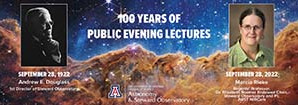
100 Years of Public Evening Lectures
Lavinia Steward made her historic contribution of $60,000 to the University of Arizona “…TO BUY TELESCOPE OF HUGE SIZE,” on October 18, 1916. However, the United States entry into World War I delayed the construction of the Steward Telescope and its 36-inch mirror. That original Steward Telescope was finally used for the first time on July 17, 1922. It would take another 9 months before the Steward Observatory and Telescope would be formally and officially dedicated on April 23, 1923.
The Telescope, however, was ready to be used before the official dedication date and Prof. Andrew Ellicott Douglass, the first Director of Steward Observatory, did not leave the telescope idle. He invited members of the campus and Tucson communities to view the wonders of the night sky through this new, large (for the time) telescope. The date was September 28, 1922, and the Steward Observatory Public Evenings were born.
We are thrilled to able to celebrate 100 years of presenting lectures on astronomy and telescope viewing to the public by offering a special Public Evening Lecture on the 100th Anniversary of the very first Steward Public Evening.
Lecture Information - Fall 2022 - Mark Your Calendars!
Monday, September 19
100 Years of Steward Observatory
Dr. Thomas Fleming and Dr. Buell Jannuzi, Steward Observatory
Wednesday, September 28 - Celebrating 100 Years!
The Webb Telescope: Starting Steward Observatory's Next 100 Years
Dr. Marcia Rieke, Regents Professor, Dr. Elizabeth Roemer Endowed Chair, Steward Observatory
Monday, October 3
Imaging Black Holes with the Event Horizon Telescope
Dr. Daniel Marone, Steward Observatory
Monday October 17
Floating Above Antarctica: The GUSTO Mission
Dr. Christopher Walker, Steward Observatory
Location: Steward Observatory N210
Doors open at 7:00 pm and Lectures begin at 7:30 pm MST
Nearest parking 2nd Street or Cherry Ave Garage
Telescope viewing follows at 8:30 PM - Weather Permitting
In-Person or Watch via NEW ZOOM link https://arizona.zoom.us/j/4470189357
Pages

For Public
Public events include our Monday Night Lecture Series, world-reknowned Astronomy Camp and Mt Lemmon Sky Center.

For Students
A good place to start if you want to become an undergrad major or grad student, or need to find our schedule of classes.

For Scientists
Find telescopes and instruments, telescope time applications, staff and mountain contacts, and faculty and staff scientific interests.




